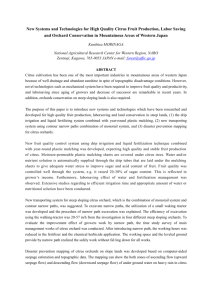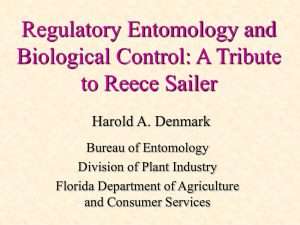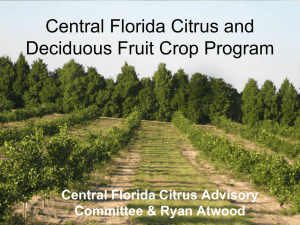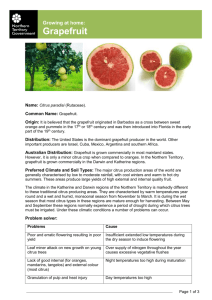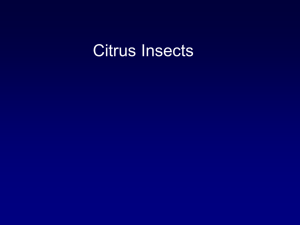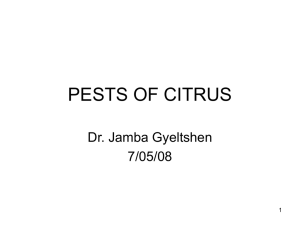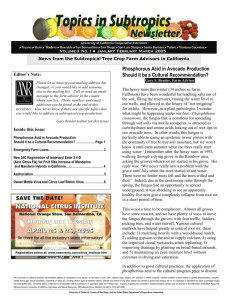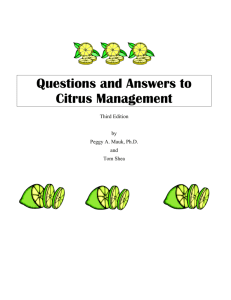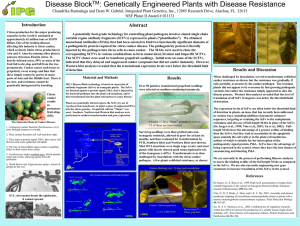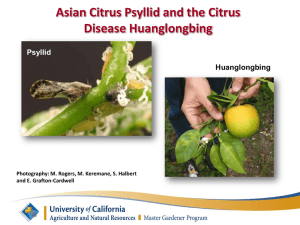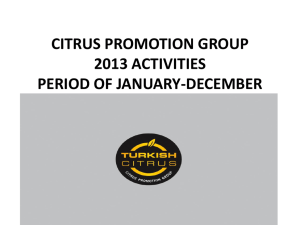the Powerpoint.
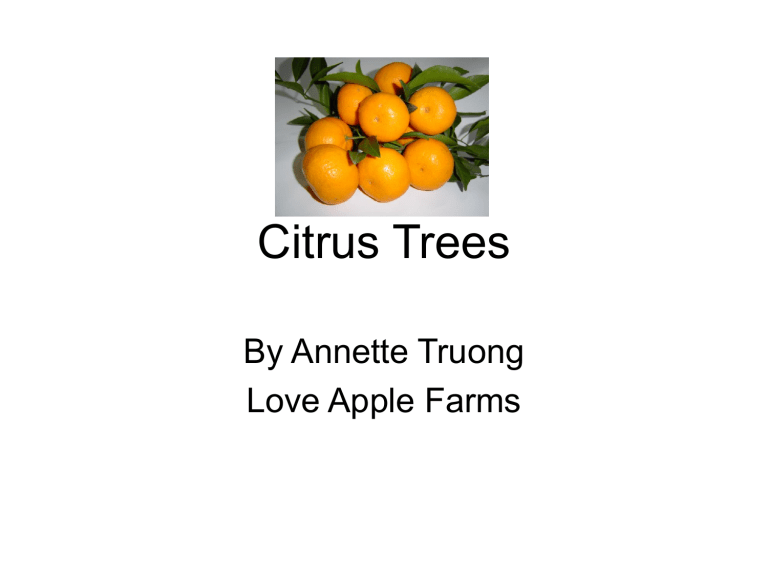
Citrus Trees
By Annette Truong
Love Apple Farms
Agenda
• 9-10 Lecture
• 10-10:30 Planting outside
• 10:30-11 Tasting
• 11-12 Budding
Background
• Volunteering at Gene
Lester’s citrus orchard for 1.5 years.
• Gene grows over
200 varieties of citrus and provides his citrus to Manresa restaurant
Citrus Basics
For Northern California
Classification (Wikipedia)
• Citrus is a common term and genus ( Citrus ) of flowering plants in the rue family, Rutaceae .
Citrus is believed to have originated in the part of Southeast Asia bordered by
Northeastern
India , Myanmar (Burma) and the Yunnan province of China
Characteristics
• Citrus trees are evergreen. The leaves look like those of deciduous trees but they don’t fall off in the same way and the tree doesn’t go dormant.
Thorns!
• Citrus trees are thorny!
• Australian citrus have smaller leaves and more bristly thorns
Fruiting times
• They bear fruit all year long, favoring late winter
• I don’t really understand charts like this: most orange trees will have some ripe fruit present all year long
Climate
• Citrus grow well in subtropical climates
• They can even grow in deserts (Arizona)
• Drought tolerant (similar needs to cactus)
• Somewhat cold tolerant (can withstand some freezing)
Fruit variability by location
• Variability among flavor and other fruit characteristics varies widely by climate
• The same tree will produce fruit that tastes different if grown in hotter or colder regions.
• San Jose vs Santa Cruz vs San Joaquin valley
– regional differences
Basic conditions
• In general, citrus are heat-loving
• Southern exposure, full sun
• Well drained (sandy) soil
• Soil pH: low (high acid) 6 or lower
Nutrition
• Monthly feeding
• Acid-loving fertilizer: 30-10-10
– Gene recommends
“Miracid” but you can choose organic as long as it is high nitrogen
• Foliar as well as ground feeding
• Container-grown need special care with nutrition. Nitrogen deficiency is easy to get
Micronutrients
Probably in your soil
Potassium deficiency results in smaller fruit
There are a myriad of reasons why citrus leaves yellow!
Fertilizing (con’t)
• Container fertilizing
– Much more important than in-ground
– The pot soil leeches out more quickly
– Once per month is ok, just never forget
(more important)
Soil pH & nutrition uptake
• Lowering the pH of your soil will help your tree’s nutrition uptake
• Acid loving - pH test your soil yourself
• Most soil in this area is neutral.
• Sulfur, peat, iron sulfate will lower pH
• If your pH goes above 7 your tree will yellow and look sickly
No Salt!
Citrus will NOT tolerate Boron or salty soil.
Temperature effects
Temperature vs Growth
• Growth happens above 55 degrees
• When the temperature drops below 55 consistently, you can stop fertilizing as the tree is not using it anyway
(most hardy)
Kumquat
Satsuma
Sweet Orange
Cold Hardiness
Sustained <28 degrees will cause damage, any lower could kill the plant. Frost protection for may be needed (mulch & wrap).
Navel Orange
Mandarin
Grapefruit
Tangerine
Tangelo
Lemon
Lime
(least hardy)
Acid Level
• Low temperature = sour.
– Favors fruit that is attuned to high acid.
• Lemons from
Florida will not have the same tangy sourness as those from Santa Barbara
Sugar Level
• Sugar level
– High temperature == sweet.
Fruit will reach full sugar potential
– Grapefruit from Santa Barbara will not be as sweet as that grown in Florida
– Acid & Sugar in balance == high flavor
– High acid / low sugar == sour flavor
– High sugar / no acid == no flavor
…and there’s also bitterness
– Grapefuits & pummelos will also not get very sweet in our area
– takes 14-16 months to sweeten up
• Bitterness vs. sourness: Not the same thing
• bitter & sour == cold climates
– California grapefruit
• bitter & sweeter == hot climates
– Florida grapefruit
Color of blood oranges
• Blood oranges don’t “color up” as well in cooler climates
• They color up extremely well at LindCove (UC Riverside)
• There is some combination of temperature and climate and ripening duration that needs to be met for coloration to occur
Thick Rinds
– Grapefruits and pummelos will develop a thicker rind in a cooler climate
– Night time temperatures, plus overall 24 hour temperature average
– Also phosphorus deficiency
Problems
Most CommonProblems
• Nutrition deficiencies
• Insect damage (mainly snails and aphids)
• Gopher damage (roots)
• Not enough drainage (root rot)
• Fungus, bacteria
• Temperature (too cold or hot)
• Severe drought
• http://www.ipm.ucdavis.edu/PMG/C107/m107bpleaftwigdis.html
Macronutrient deficiencies
• Low Nitrogen = yellow leaves, pale
& smooth fruit peel
• Low Phosphorus = hollow core, thicker rind
• Low Potassium = smaller fruit
Micronutrient deficiencies http://www.crec.ifas.ufl.edu/extension/greening/ndccg.shtml
Pollination
• For fruit set, pollination is required (bees or by hand)
• Self-pollination (same-variety) results in fewer seeds
– Pollen grain from same plant variety
– This is why orchards plant varieties in blocks
– The middle of the block will be essentially seedless
– Trees on the edges may have more seeds due to external pollen sources brought in
• Cross-pollination results in more seeds
– “Seedless” may become “seedy”
– There is some leeway in the variety itself
Pruning
• Remove water sprouts
• If shaping: remove no more than a third of the tree in one year
• Keep the aprons! Citrus will naturally form globe-shaped trees with branches to the ground. Essential in hot climates
• Can be trained and pruned decoratively
Planting
• Well-drained (sandy) soil
– Start with some kind of loamy loose soil (top soil).
Mix in organic matter and sand
– For pots, just use potting soil
• Mound first with sandy soil on top of the existing elevation (18” high, 36” diameter), with a flat top on the top of the cone with a bit of a dish so the water doesn’t run out after the cone solidifies
Staking is not required
Irrigation
• Drip irrigation makes watering easy
– 2-3 hours on mature trees, when the trees seem water stressed. Don’t let them wilt too much. Non-water stressed leaves are shiny and flat. When they start to get dull and curl a bit, they are water stressed.
– In the summer, one deep watering every
3-4 weeks
– New trees: every week or 2.
• Mulching
– Use wood chips, a few inches deep
– Shades the roots, helps retain moisture

